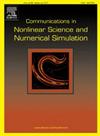求解四阶时间分数扩散方程的快速高阶局部无网格方法
IF 3.4
2区 数学
Q1 MATHEMATICS, APPLIED
Communications in Nonlinear Science and Numerical Simulation
Pub Date : 2025-01-03
DOI:10.1016/j.cnsns.2024.108586
引用次数: 0
摘要
本文提出了一种求解二维(2D)四阶扩散方程的局部无网格配置技术,该方程具有阶数α∈(0,1)的Caputo时间分数阶导数。引入辅助变量将原来的四阶问题转化为等效的二阶系统,保持了精确解在初始时刻的弱奇异性。构造了两种时间半离散格式:第一种格式利用标准Alikhanov公式在一般时间网格(包括均匀网格和非均匀网格)上近似Caputo分数阶导数;第二种方法采用快速Alikhanov公式,该公式来源于指数和(soe)技术,以降低计算成本和存储需求。然后采用局部径向基函数统一划分(LRBF-PU)配置方法进行空间离散化,得到两种不同的完全离散方案。用L2和H1能量方法证明了这两种时间半离散格式的无条件稳定性和收敛性。收敛性分析表明,通过选择合适的时间网格参数γ,算法在时间上获得了最优的二阶精度,而时间网格参数γ会影响时间收敛速度。在均匀节点和分散节点的规则和不规则空间域上的数值结果验证了算法的准确性、有效性和鲁棒性,验证了理论分析的正确性。本文章由计算机程序翻译,如有差异,请以英文原文为准。
A fast and high-order localized meshless method for fourth-order time-fractional diffusion equations
This paper develops a localized meshless collocation technique for solving the two-dimensional (2D) fourth-order diffusion equation with the Caputo time-fractional derivative of order . An auxiliary variable is introduced to transform the original fourth-order problem into an equivalent second-order system, preserving the weak singularity of the exact solution at the initial time. Two time semi-discrete schemes are constructed: the first utilizes the standard Alikhanov formula on general time meshes, including both uniform and nonuniform meshes, to approximate the Caputo fractional derivative; the second employs the fast Alikhanov formula, derived from the sum-of-exponentials (SOEs) technique, to reduce computational costs and storage requirements. The local radial basis function partition of unity (LRBF-PU) collocation method is then used for spatial discretization, resulting in two distinct fully discrete schemes. The unconditional stability and convergence of both time semi-discrete schemes are proved by and energy methods. Convergence analysis reveals that the algorithms achieve optimal second-order accuracy in time by selecting an appropriate time mesh parameter , which influences the temporal convergence rate. Numerical results on regular and irregular spatial domains with uniform and scattered nodes demonstrate the accuracy, efficiency, and robustness of the proposed algorithms, confirming the theoretical analysis.
求助全文
通过发布文献求助,成功后即可免费获取论文全文。
去求助
来源期刊

Communications in Nonlinear Science and Numerical Simulation
MATHEMATICS, APPLIED-MATHEMATICS, INTERDISCIPLINARY APPLICATIONS
CiteScore
6.80
自引率
7.70%
发文量
378
审稿时长
78 days
期刊介绍:
The journal publishes original research findings on experimental observation, mathematical modeling, theoretical analysis and numerical simulation, for more accurate description, better prediction or novel application, of nonlinear phenomena in science and engineering. It offers a venue for researchers to make rapid exchange of ideas and techniques in nonlinear science and complexity.
The submission of manuscripts with cross-disciplinary approaches in nonlinear science and complexity is particularly encouraged.
Topics of interest:
Nonlinear differential or delay equations, Lie group analysis and asymptotic methods, Discontinuous systems, Fractals, Fractional calculus and dynamics, Nonlinear effects in quantum mechanics, Nonlinear stochastic processes, Experimental nonlinear science, Time-series and signal analysis, Computational methods and simulations in nonlinear science and engineering, Control of dynamical systems, Synchronization, Lyapunov analysis, High-dimensional chaos and turbulence, Chaos in Hamiltonian systems, Integrable systems and solitons, Collective behavior in many-body systems, Biological physics and networks, Nonlinear mechanical systems, Complex systems and complexity.
No length limitation for contributions is set, but only concisely written manuscripts are published. Brief papers are published on the basis of Rapid Communications. Discussions of previously published papers are welcome.
 求助内容:
求助内容: 应助结果提醒方式:
应助结果提醒方式:


